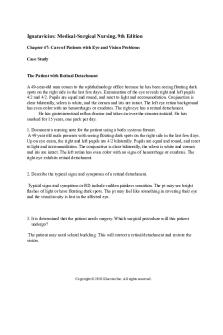Ch. 4.7 Notes PDF

| Title | Ch. 4.7 Notes |
|---|---|
| Course | Nutrition |
| Institution | University of Massachusetts Amherst |
| Pages | 1 |
| File Size | 37.6 KB |
| File Type | |
| Total Downloads | 70 |
| Total Views | 186 |
Summary
Textbook Notes...
Description
✨What’s the Story on Alternative Sweeteners?✨ Voca ocabbular ulary y Nutriti utritive ve SSweeteners: weeteners: Sweeteners such as sucrose, fructose, honey, and brown sugar that contribute energy Sug Sugar ar Alco Alcoho ho hols ls ls:: Other nutritive sweeteners such as mannitol, sorbitol, isomalt, and xylitol Nonn onnutriti utriti utritive ve ve//Alternat Alternatiive SSweeteners: weeteners: Products developed to sweeten foods without promoting tooth decay and weight gain which provide little or no energy Accepta cceptabble Daily Intak Intakee (ADI): Estimates of the amount of a nonnutritive sweetener that someone can consume each day over a lifetime without adverse effects Saccharin: A sweetener that is about 300 times sweeter than sucrose Acesulf cesulfame ame Potassium (A (Acesulf cesulf cesulfame-K): ame-K): Calorie-free sweetener that is 200 times sweeter than sugar and is marketed under the names Sunette and Sweet One Aspartame Aspartame:: One of the most popular alternative sweeteners currently in use, which is composed of two amino acids (phenylalanine and aspartic acid) and is also called Equal and NutraSweet Phenylk henylketo eto eton nuria (PKU): Genetic disorder that prevents the breakdown of the amino acid phenylalanine Sucra Sucralose: lose: A sweetener made from sucrose and marketed under the brand name Splenda Neotame eotame:: An alternative sweetener that is 7,000 times sweeter than sugar Stevia: An alternative sweetener produced from a purified extract of the stevia plant native to South America, which is 200 times sweeter than sugar Advantame: An alternative sweetener that is calorie-free and 20,000 time sweeter than sugar Important FFacts acts ● Foods with sugar alcohols have health benefits that foods made with sugars do not have, such as a reduced glycemic response and decreased risk of dental caries. ● Because sugar alcohols are absorbed slowly and incompletely from the intestine, they provide less energy than sugar, usually 2 to 3 kcal of energy per gram. ● The body does not metabolize acesulfame-K, so it is excreted unchanged by the kidneys. ● The ADI for acesulfame-K is 15 mg per kg of body weight per day. ● The ADI for aspartame is 50 mg per kg of body weight per day. ● Because a person with PKU cannot metabolize phenylalanine, it builds up to toxic levels in the tissues of the body and causes irreversible brain damage. ● The ADI for sucralose is 5 mg per kg of body weight per day....
Similar Free PDFs

C47 - ch 47 test bank
- 7 Pages

47 Antimicobacterianos
- 9 Pages

Special Senses - Lecture notes 1-47
- 47 Pages

S.47 oapa - Lecture notes 5
- 2 Pages

Esercitazione 47 pt 4
- 2 Pages

Biology Chapter 47 Preclass
- 10 Pages

Module 45 - 47
- 5 Pages

Chapter 47 Practice Test
- 21 Pages

Fase2 212019-47 colaborativo
- 4 Pages

Capitulo 47, Guyton - Summary
- 3 Pages

47 Matematika Diskrit
- 28 Pages

Note 47 - study guide
- 6 Pages
Popular Institutions
- Tinajero National High School - Annex
- Politeknik Caltex Riau
- Yokohama City University
- SGT University
- University of Al-Qadisiyah
- Divine Word College of Vigan
- Techniek College Rotterdam
- Universidade de Santiago
- Universiti Teknologi MARA Cawangan Johor Kampus Pasir Gudang
- Poltekkes Kemenkes Yogyakarta
- Baguio City National High School
- Colegio san marcos
- preparatoria uno
- Centro de Bachillerato Tecnológico Industrial y de Servicios No. 107
- Dalian Maritime University
- Quang Trung Secondary School
- Colegio Tecnológico en Informática
- Corporación Regional de Educación Superior
- Grupo CEDVA
- Dar Al Uloom University
- Centro de Estudios Preuniversitarios de la Universidad Nacional de Ingeniería
- 上智大学
- Aakash International School, Nuna Majara
- San Felipe Neri Catholic School
- Kang Chiao International School - New Taipei City
- Misamis Occidental National High School
- Institución Educativa Escuela Normal Juan Ladrilleros
- Kolehiyo ng Pantukan
- Batanes State College
- Instituto Continental
- Sekolah Menengah Kejuruan Kesehatan Kaltara (Tarakan)
- Colegio de La Inmaculada Concepcion - Cebu



